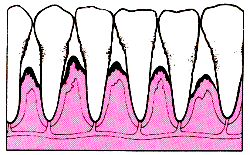SAVING YOUR TOOTH
There are many reasons to save a compromised tooth, and in most cases, they far outweigh the loss of a tooth. Making the choice to save your tooth today can make a significant difference in the way you chew, talk, smile, and interact with others. Retaining your natural teeth for a lifetime helps ensure more youthful appearance and social ease, as well.
This page should help you to understand why restoration through crown and bridge treatment is so important, and what the procedure involves.
What are the most common causes of tooth loss?
Often, people seek out emergency dental care when they are in pain. Some of the most common reasons for emergency visits to the dental office include:
- A broken or fractured tooth
- An abscess (infection) of the pulp (nerve) of the tooth
- A periodontal (gum) infection or inflammation
- Mobile (loose) teeth
- A badly decayed tooth
- A lost filling
- A knocked out (avulsed) tooth
How can my tooth be saved?
First, the dentist must make an accurate diagnosis, to determine the exact nature of the problem. Usually, this involves taking an X-ray, making a clinical examination and taking a thorough medical/dental history. Depending upon the diagnosis, the dentist will usually make the following recommendations to save a compromised tooth.

A tooth with a fractured cusp.

An abscessed (infected) tooth.

Teeth with advanced periodontal disease.

Badly decayed teeth.

Knocked out Tooth
Often, parents think, "It's only a baby tooth, why save it?" There are many reasons. First, the health and alignment of the permanent teeth are directly correlated to the health of the baby teeth. Children with severely decayed baby teeth may undergo a number of procedures to preserve the alignment of baby teeth, strengthen chewing and speech ability, and to ensure normal growth pattern of the jaws.
Your dentist may elect to save your child's baby tooth/teeth with any of the following treatments:
- A space maintainer
- Silver fillings
- Stainless steel crowns
- Pulpotomy (removal of a portion of infected nerve)
- Special orthodontic devices
What are the advantages and benefits of saving a tooth?
In the long run, there are many reasons to save your tooth. As a preventive measure, early treatment is always less expensive than involved treatment. Patients with tooth loss often find themselves with unpleasant results, including, further tooth loss, advanced periodontal disease, poor chewing function, TMJ problems, compromised speech and lowered self-confidence.




